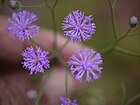Note: This is a project under development. The articles on this wiki are just being initiated and broadly incomplete. You can Help creating new pages.
Difference between revisions of "Cyanthillium cinereum - Sahadevi"
(→Fruit) |
(→Uses) |
||
| Line 3: | Line 3: | ||
==Uses== | ==Uses== | ||
| − | {{Uses|Wound healing}}, {{Uses|Renal calculi}}, {{Uses|Burning micturition}}, {{Uses| | + | {{Uses|Wound healing}}, {{Uses|Renal calculi}}, {{Uses|Burning micturition}}, {{Uses|Insomnia}}, {{Uses|Skin diseases}}, {{Uses|Intestinal worms}} |
<ref name="Uses"/> | <ref name="Uses"/> | ||
Revision as of 17:55, 29 April 2019
Sahadevi is an erect, branching, annual plant growing 15 - 80cm tall. The plant is harvested from the wild for local use as a food and medicine.
Contents
- 1 Uses
- 2 Parts Used
- 3 Chemical Composition
- 4 Common names
- 5 Properties
- 6 Habit
- 7 Identification
- 8 List of Ayurvedic medicine in which the herb is used
- 9 Where to get the saplings
- 10 Mode of Propagation
- 11 How to plant/cultivate
- 12 Commonly seen growing in areas
- 13 Photo Gallery
- 14 References
- 15 External Links
Uses
Wound healing, Renal calculi, Burning micturition, Insomnia, Skin diseases, Intestinal worms [1]
Parts Used
Chemical Composition
Common names
| Language | Common name |
|---|---|
| Kannada | dandothpala, gaaya doppalu, gaayathoppalu, kaadu hoge soppu, sahadevi |
| Hindi | daudotpala, kalgira, kaljiri, sadodi, sadori, sahadevi |
| Malayalam | puvamkuruntal |
| Tamil | cakatevi, cirilai, citevi, cenkalunir, puvamkuruntal |
| Telugu | garita kammi, garitikamma, gharitikamini |
| Marathi | NA |
| Gujarathi | NA |
| Punjabi | NA |
| Kashmiri | NA |
| Sanskrit | sahadevi, ardhaprasadana, dandotpala, vishvadeva |
| English | ash-colour fleabane, purple fleabane |
Properties
Reference: Dravya - Substance, Rasa - Taste, Guna - Qualities, Veerya - Potency, Vipaka - Post-digesion effect, Karma - Pharmacological activity, Prabhava - Therepeutics.
Dravya
Rasa
Tikta (Bitter)
Guna
Laghu (Light), Rooksha (Dry)
Veerya
Ushna (Hot)
Vipaka
Katu (Pungent)
Karma
Kapha, Vata
Prabhava
Habit
{{Habit|Herb}
Identification
Leaf
| Kind | Shape | Feature |
|---|---|---|
| Simple | alternate | Leaves variable, 2-8 x 1-3 cm, ovate, acute at both ends, thinly hairy below; petiole 1-2 cm long, slender. |
Flower
| Type | Size | Color and composition | Stamen | More information |
|---|---|---|---|---|
| Bisexual | terminal corymbose heads | Pink | peduncled; outer bracts minute, inner oblong, acute, cuspidate, hairy. Flowers 5-10, similar; corolla 3 mm long, glabrous, bluish-purple. |
Fruit
| Type | Size | Mass | Appearance | Seeds | More information |
|---|---|---|---|---|---|
| Achene | 1.5 mm long | hairy; outer pappus 1 mm long, setaceous, inner 3 mm long. | {{{6}}} |
Other features
List of Ayurvedic medicine in which the herb is used
Where to get the saplings
Mode of Propagation
How to plant/cultivate
Season to grow
Soil type
Propagation
Commonly seen growing in areas
Tropical areaSub tropical area
Photo Gallery
References
External Links
Categories:
- Ayurvedic Herbs known to be helpful to treat Wound healing
- Ayurvedic Herbs known to be helpful to treat Renal calculi
- Ayurvedic Herbs known to be helpful to treat Burning micturition
- Ayurvedic Herbs known to be helpful to treat Insomnia
- Ayurvedic Herbs known to be helpful to treat Skin diseases
- Ayurvedic Herbs known to be helpful to treat Intestinal worms
- Herbs with Root used in medicine
- Herbs with common name in Kannada
- Herbs with common name in Hindi
- Herbs with common name in Malayalam
- Herbs with common name in Tamil
- Herbs with common name in Telugu
- Herbs with common name in Sanskrit
- Herbs with common name in English
- Index of Plants which can be propagated by Seeds
- Herbs that are commonly seen in the region of Tropical area
- Herbs that are commonly seen in the region of Sub tropical area
- Herbs
- Herb




